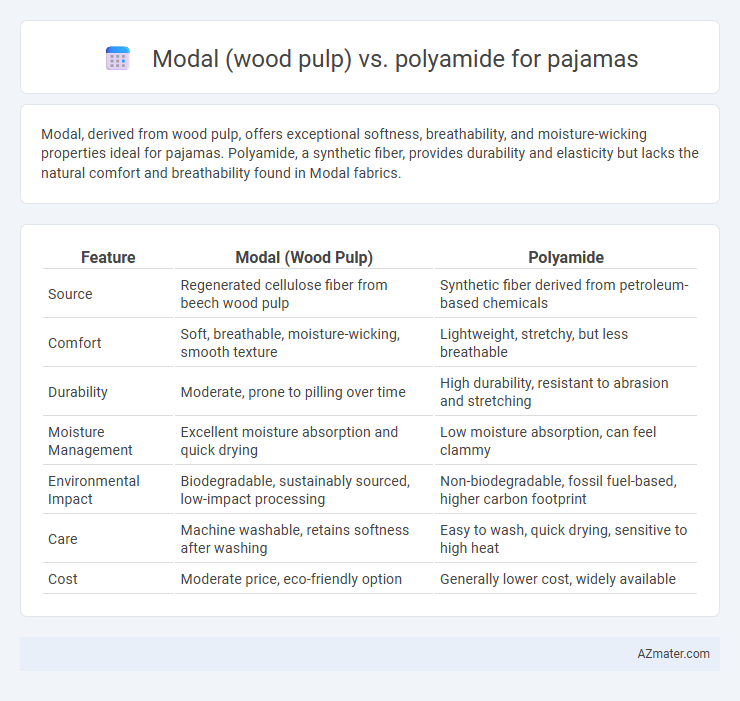Modal, derived from wood pulp, offers exceptional softness, breathability, and moisture-wicking properties ideal for pajamas. Polyamide, a synthetic fiber, provides durability and elasticity but lacks the natural comfort and breathability found in Modal fabrics.
Table of Comparison
| Feature | Modal (Wood Pulp) | Polyamide |
|---|---|---|
| Source | Regenerated cellulose fiber from beech wood pulp | Synthetic fiber derived from petroleum-based chemicals |
| Comfort | Soft, breathable, moisture-wicking, smooth texture | Lightweight, stretchy, but less breathable |
| Durability | Moderate, prone to pilling over time | High durability, resistant to abrasion and stretching |
| Moisture Management | Excellent moisture absorption and quick drying | Low moisture absorption, can feel clammy |
| Environmental Impact | Biodegradable, sustainably sourced, low-impact processing | Non-biodegradable, fossil fuel-based, higher carbon footprint |
| Care | Machine washable, retains softness after washing | Easy to wash, quick drying, sensitive to high heat |
| Cost | Moderate price, eco-friendly option | Generally lower cost, widely available |
Introduction to Modal and Polyamide Fabrics
Modal fabric, derived from beech tree wood pulp, is a semi-synthetic fiber known for its exceptional softness, breathability, and moisture-wicking properties, making it ideal for comfortable sleepwear like pajamas. Polyamide, commonly referred to as nylon, is a synthetic fiber prized for its high durability, elasticity, and resistance to abrasion and wrinkles, often used in performance-oriented or blended pajama fabrics. Choosing between Modal and Polyamide depends on the desired balance of softness and durability, with Modal offering natural comfort and Polyamide providing enhanced strength and shape retention.
Origins and Production Processes
Modal, derived from beech tree wood pulp, undergoes a semi-synthetic process where cellulose is chemically treated and regenerated into fine, soft fibers ideal for pajamas due to their breathability and moisture-wicking properties. In contrast, polyamide, commonly known as nylon, is a fully synthetic fiber produced through a polymerization process using petrochemical derivatives, resulting in strong, elastic fabrics that enhance durability and stretch in sleepwear. The natural origin of modal provides eco-friendlier attributes compared to the petroleum-based, energy-intensive manufacturing of polyamide fibers.
Environmental Impact and Sustainability
Modal, derived from beech tree wood pulp, is a biodegradable and renewable fabric with a lower environmental footprint due to its sustainable forestry practices and closed-loop production process that recycles water and chemicals. Polyamide, a synthetic fiber made from petrochemicals, involves energy-intensive manufacturing and contributes to microplastic pollution, posing challenges for sustainability and environmental impact. Choosing modal pajamas supports reduced carbon emissions and promotes eco-friendly textile production, whereas polyamide pajamas offer durability but with higher ecological costs.
Comfort and Softness Comparison
Modal fabric, derived from beech wood pulp, offers exceptional breathability and a silky-soft texture, making it highly comfortable for pajamas. Polyamide, a synthetic fiber, provides durability and moisture-wicking properties but tends to feel less soft and less breathable compared to Modal. For optimal comfort and softness in sleepwear, Modal is generally preferred over Polyamide due to its natural fibers and smooth hand feel.
Breathability and Moisture Management
Modal fabric, derived from wood pulp, offers superior breathability compared to polyamide, allowing air to circulate freely and keep the body cool during sleep. Its excellent moisture-wicking properties rapidly absorb and release sweat, enhancing comfort by maintaining a dry environment. Polyamide, while durable and lightweight, tends to retain heat and moisture, making Modal the preferred choice for breathable and moisture-managing pajamas.
Durability and Longevity
Modal fabric, derived from beech wood pulp, offers excellent durability due to its strong, smooth fibers that resist wear and shrinkage over time. Polyamide, a synthetic material known for its high tensile strength and abrasion resistance, provides exceptional longevity, maintaining shape and color after numerous washes. When comparing pajamas, Modal ensures breathable comfort with moderate durability, while Polyamide excels in toughness and long-lasting resilience.
Hypoallergenic and Skin-Friendliness
Modal, derived from wood pulp, offers superior hypoallergenic properties and high skin-friendliness due to its natural origin and smooth, breathable fibers that reduce irritation and moisture retention. Polyamide, a synthetic fabric, tends to be less breathable and may trap heat and sweat, potentially causing discomfort or allergic reactions for sensitive skin. Choosing Modal pajamas supports a gentle, irritation-free experience, especially for those with sensitive or allergy-prone skin.
Care and Maintenance Requirements
Modal pajama fabric, derived from beech wood pulp, offers excellent moisture-wicking and breathability, requiring gentle machine wash in cold water and low-heat drying to maintain its softness and prevent shrinkage. Polyamide pajamas, made from synthetic nylon fibers, demand careful washing in cool water with mild detergent and should be air-dried or tumble dried on low to avoid damage and retain elasticity. Both fabrics benefit from avoiding bleach and high heat to preserve color vibrancy and fabric integrity during care and maintenance.
Price and Value for Pajama Shoppers
Modal, derived from beech wood pulp, offers a soft, breathable, and moisture-wicking fabric at a moderate price point, making it an excellent choice for pajama shoppers seeking comfort and durability. Polyamide, commonly known as nylon, tends to be more affordable but lacks the same level of breathability and natural softness, potentially reducing overall comfort during sleep. Shoppers prioritizing long-term value and luxurious feel often find modal pajamas to be a superior investment despite a slightly higher cost.
Choosing the Best Fabric for Your Pajamas
Modal, derived from beech wood pulp, offers a silky softness and excellent breathability, making it ideal for lightweight, moisture-wicking pajamas that enhance comfort during sleep. Polyamide, a synthetic fabric known for its durability and elasticity, provides stretch and resilience but may lack the natural breathability found in modal. When choosing the best fabric for pajamas, prioritize modal for its eco-friendly properties and comfort, while polyamide suits those needing enhanced fit and durability for active lounging.

Infographic: Modal (wood pulp) vs Polyamide for Pajama
 azmater.com
azmater.com